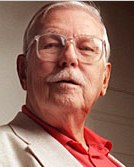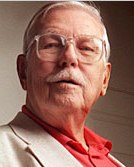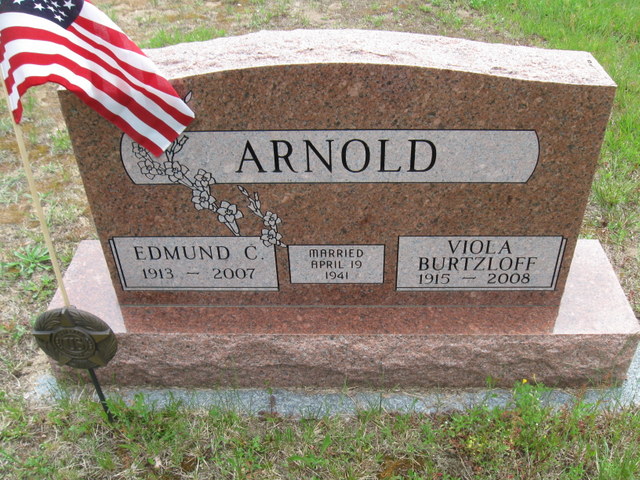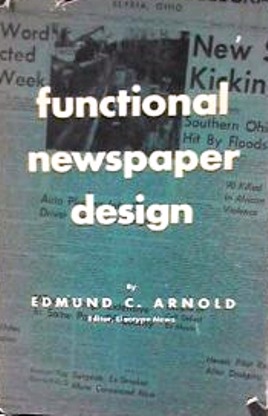The cause was respiratory failure, said his daughter Kathy Loomis.
Over the course of his career, Mr. Arnold designed or redesigned hundreds of newspapers, including The Chicago Tribune, The Christian Science Monitor, Newsday, The Boston Globe, The Louisville Courier-Journal, The National Observer, The Toronto Star, The Kansas City Star, and El Vocero and El Mundo in San Juan, P.R. He also taught newspaper design and wrote books long considered standard references on newspaper typography.
When Mr. Arnold took his first fresh look at newspapers, many had long rejected the vigorous graphic displays common in the turn-of-the-century papers. He believed that the prevalent designs, which often featured monotonous narrow vertical columns of type and large horizontal headlines, had been foisted on papers largely because trained typographers and designers were not usually involved in the layout decisions, which were made by editors working directly with printers and compositors. He pushed publishers to give designers and typographers more influence, to move design out of the typesetting room and onto the drawing board. He also developed ideas like horizontal (and modular) layouts and encouraged the use of varied graphic elements to draw the reader's eyes.
Edmund C. Arnold was born in Bay City, Mich., June 25, 1913. As a boy he lettered signs and drew pictures. During the World War II he edited a newspaper for the 70th Infantry Division as it moved through Europe. Later, as editor and co-owner of The Frankenmuth News in Michigan, he developed an abiding interest in typography. Then, as picture editor of The Saginaw News, he did layouts as well.
He moved to New York City in 1954 to become editor of the widely read Linotype News, a publication of the Mergenthaler Linotype Company, which manufactured typesetting equipment. Through his work for the journal and through 44 years of writing a column on typography in The Publishers' Auxiliary, a weekly trade journal, he became an influential newspaper design advocate. His column always ended with "Arnold's Ancient Axiom," which offered his rules for better design.
These axioms formed the basis for 27 books on typography, including Functional Newspaper Design, considered the bible of newspaper typography; Ink on Paper, an introduction to the graphic arts used in journalism schools for decades; and The Student Journalist, a textbook for high school newspapers, written with Hillier Krieghbaum.
In 1960 he became a professor at the S.I. Newhouse School of Public Communications at Syracuse University, and in 1975 was named head of the graphic arts department at Virginia Commonwealth University. He retired in 1983 but continued to consult and conduct workshops.
He received the George Polk Memorial Award in 1957 for his contribution to American journalism through typographical design.
In addition to his daughter Ms. Loomis, who lives in Louisville, Ky., Mr. Arnold is survived by his wife of 65 years, Viola Arnold; another daughter, Bethany Uhl of Roanoke; a son, Bruce Arnold of Sydney, Australia; and five grandchildren.
The cause was respiratory failure, said his daughter Kathy Loomis.
Over the course of his career, Mr. Arnold designed or redesigned hundreds of newspapers, including The Chicago Tribune, The Christian Science Monitor, Newsday, The Boston Globe, The Louisville Courier-Journal, The National Observer, The Toronto Star, The Kansas City Star, and El Vocero and El Mundo in San Juan, P.R. He also taught newspaper design and wrote books long considered standard references on newspaper typography.
When Mr. Arnold took his first fresh look at newspapers, many had long rejected the vigorous graphic displays common in the turn-of-the-century papers. He believed that the prevalent designs, which often featured monotonous narrow vertical columns of type and large horizontal headlines, had been foisted on papers largely because trained typographers and designers were not usually involved in the layout decisions, which were made by editors working directly with printers and compositors. He pushed publishers to give designers and typographers more influence, to move design out of the typesetting room and onto the drawing board. He also developed ideas like horizontal (and modular) layouts and encouraged the use of varied graphic elements to draw the reader's eyes.
Edmund C. Arnold was born in Bay City, Mich., June 25, 1913. As a boy he lettered signs and drew pictures. During the World War II he edited a newspaper for the 70th Infantry Division as it moved through Europe. Later, as editor and co-owner of The Frankenmuth News in Michigan, he developed an abiding interest in typography. Then, as picture editor of The Saginaw News, he did layouts as well.
He moved to New York City in 1954 to become editor of the widely read Linotype News, a publication of the Mergenthaler Linotype Company, which manufactured typesetting equipment. Through his work for the journal and through 44 years of writing a column on typography in The Publishers' Auxiliary, a weekly trade journal, he became an influential newspaper design advocate. His column always ended with "Arnold's Ancient Axiom," which offered his rules for better design.
These axioms formed the basis for 27 books on typography, including Functional Newspaper Design, considered the bible of newspaper typography; Ink on Paper, an introduction to the graphic arts used in journalism schools for decades; and The Student Journalist, a textbook for high school newspapers, written with Hillier Krieghbaum.
In 1960 he became a professor at the S.I. Newhouse School of Public Communications at Syracuse University, and in 1975 was named head of the graphic arts department at Virginia Commonwealth University. He retired in 1983 but continued to consult and conduct workshops.
He received the George Polk Memorial Award in 1957 for his contribution to American journalism through typographical design.
In addition to his daughter Ms. Loomis, who lives in Louisville, Ky., Mr. Arnold is survived by his wife of 65 years, Viola Arnold; another daughter, Bethany Uhl of Roanoke; a son, Bruce Arnold of Sydney, Australia; and five grandchildren.
Family Members
Sponsored by Ancestry
Advertisement
Advertisement












